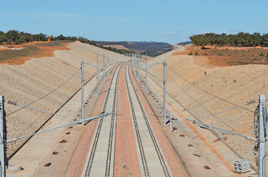He says the project is vital because “there was no important city to city route”. Furthermore, he understands that when the Moroccan HS line opens, freight will operate on the longer route, but will then be able to serve other ports, thus opening up new business opportunities. Construction of the HS line therefore serves as more than just a piece of infrastructure to improve point-to-point journey times. There are no stations on this first phase of the line.
Colas must meet eight key deadlines in the project and, so far, it has met them all. On September 2 2013 it was awarded the VCBT contract; on June 1 2014 there was acceptance of works at the Kenitra work base, and on January 31 2015 work began on ballast deliveries and rail storage.
By December 2 2015 the high-speed line work order was confirmed, with a commitment for 1,000 metres of high-speed line built per day. By October 1 2016 there had to be 40% of the project completed (around 50km).
Testing and commissioning began, as planned, in February this year. The next deadline is October, when the construction work finishes ahead of the start of technical service and VCBT works acceptance.
The contracting authority is ONCF (National Office of Railways), and the contracting authority support is provided by SNCF International. Douriez is the legal representative for Colas Rail as the Project Director, and a steering committee is in place with three members from the contractors (one each).
At the workbases, different tasks are under way. The Kenitra site (about 70 hectares in size) was created under customer request, and is currently dedicated to the HS project. It also acts as a training centre. Staff are trained in specific duties relating to the construction of the railway, including the operation of construction trains, worker safety and security.
A model railway is housed in one of the buildings. While not a 100% replica of the HS route, it helps in teaching the processes required in the construction and operation, and is used to mimic the line. Currently it is being used for the engineering trains and their various movements, but in time test trains and HS running will be taught using this method.
The site uses both French and Arabic languages (as per most of Morocco), while radio communications are all in French.
Training at Kenitra also involves theory sessions on railway and hygiene safety, with practical sessions. At the time of RAIL’s visit, 1,393 workers had been trained (1,147 in railway safety and 246 in hygiene and safety). This had been achieved through 258 sessions, including 231 railway safety sessions.
What’s fascinating about this railway is that Colas is constructing it first as a road, before then carrying out railway works.
Initial work includes topography and siting of OLE posts. Then the road construction work begins. This involves excavation so that the catenary posts can be installed alongside the railway, which at this point continues to resemble a road rather than a multi-billion-pound railway. Once the masts are in place, the feeder wires are unreeled and strung between the masts (using road transport).
Next, the sleepers are sited along the railway before pre-ballasting takes place. This enables 30% of this particular part of the project to be completed in one go.
By constructing the railway in this manner, Colas Rail is able to let the land settle and (in effect) lay the railway on the road, having already dealt with issues such as drainage and the land subsiding.
When it comes to the railway works, the sleepers are laid on the pre-ballast before continuously welded rail is brought to the site. Douriez explains that the record for laying track is 3,564 metres in one eight-hour shift.
At the same time the OLE is also brought to the site. Then ballasting is carried out. This is delivered to site by rail, with materials arriving from the logistic bases. Once the ballast is laid, heavy mechanical packing takes place using various regulators from Colas’ fleet.
Stress relief of the track is the next task, followed by OLE erection (typically around 1.2km per shift). It is the OLE installation that Douriez says tends to slow down the teams - usually around 2,000 metres of track is laid per shift. Once completed, testing begins.
Trains operating on the new HS railway will be classic compatible vehicles, although Douriez says that by 2035 the authorities want an entire HS network. The classic network in Morocco is 3,000V OLE, which means the trains must be dual-voltage.
Phase 2 of the scheme is planned to be the 50km from Kenitra into Rabat. Although not the largest city in Morocco, it is the administrative hub and needs that fast link to the increasingly industrialised northern ports.
Colas is everywhere in Morocco, building both roads and railways. Through its parent company it has been involved in HS construction around the world, and the company believes the success and innovation developed for this historic project could be put to good use in Britain when the HS2 contracts are let. Certainly, the Moroccan experience presents an excellent case.
This feature was published in RAIL 823 on 25th March 2017
















Login to comment
Comments
No comments have been made yet.